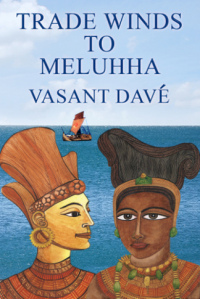‘Trade Winds to Meluhha’ Vasant Davé
A while ago I got a message from Vasant Davé, a writer in Bombay, offering me a free copy of his book. I was intrigued because it was about two civilisations, that of ancient Mesopotamia and the Indus Valley, which had always intrigued me. As an Indie writer I like to support my fellow authors and bought the book myself.
I was interested because when I was a teenager I read ‘The First Civilisations’ by Glyn Daniel. In this there is much scholarly discussion about which civilisation is oldest and which influenced the other. I almost imagined the King of Ur convening a committee to decide whether to send the concept of writing to Egypt while the Pharaoh debated whether to return the favour by sending Ur the concept of the Pyramid. What was clear from this book is that there were close links between Sumeria and the Indus Valley.
In ‘Trade Winds to Meluhha’ Vasant Davé shows that the dissemination of ideas probably took place through trade, crime, sex, passion, emotion and the desire to get on in the world.
The book concerns the adventures of a young Sumerian called Samasin along the trade routes between the cities of Sumer and the Indus Valley. It’s more than mere geographical exploration, however. Samasin is a young man and his journey includes the finding of friends, enemies and love.
It is a novel packed with character, incident and a complex plot. Many of the characters are engaging and entertaining but I felt that some characters were not fully realised and were there merely to advance the plot. Most, however, are full of life and well described.
The author did an immense amount of research for the book and has created a lively insight into these distant times. He gives a fascinating account of his research as an appendix, together with a useful glossary,
The first part of the book seemed more assured than the middle where the writing slowed a little and the language occasionally seemed uncomfortably modern. This was not helped by some of the decisions that the author took regarding names. I suspect he may have done this to make it more accessible to modern readers. However, I feel that abbreviating the beguiling names of two of the major characters to Sam and Ann stretched authenticity as did the repeated use of the terms Captain and Agent. Most of the time the author maintains a good sense of era and it was a shame when he allowed this to slip.
These few quibbles aside, ‘Trade Winds to Meluhha’ is a work which shines with the passion of the author for his subject. The characters are engaging and the story drives to a surprising conclusion. It is a fascinating insight into distant times and well worth the read.
I don’t suppose there have been many times in history when a British reader is able to read a book about two comparatively little known civilisations of four thousand years ago written by a man who lives in India. The internet and e-book revolutions have made this possible.
For me ‘Trade Winds to Meluhha’ is almost a metaphor for this new trade in ideas across the world. Samasin used the trade winds to explore his world and readers can now use these new trade winds to explore ours. I look forward to the trade wind which brings Vasant Davé’s next book blowing my way.
Related articles
Blog Tour – Trade Winds to Meluhha (terraverum.wordpress.com)
Ancient people were not static (blogs.discovermagazine.com)





